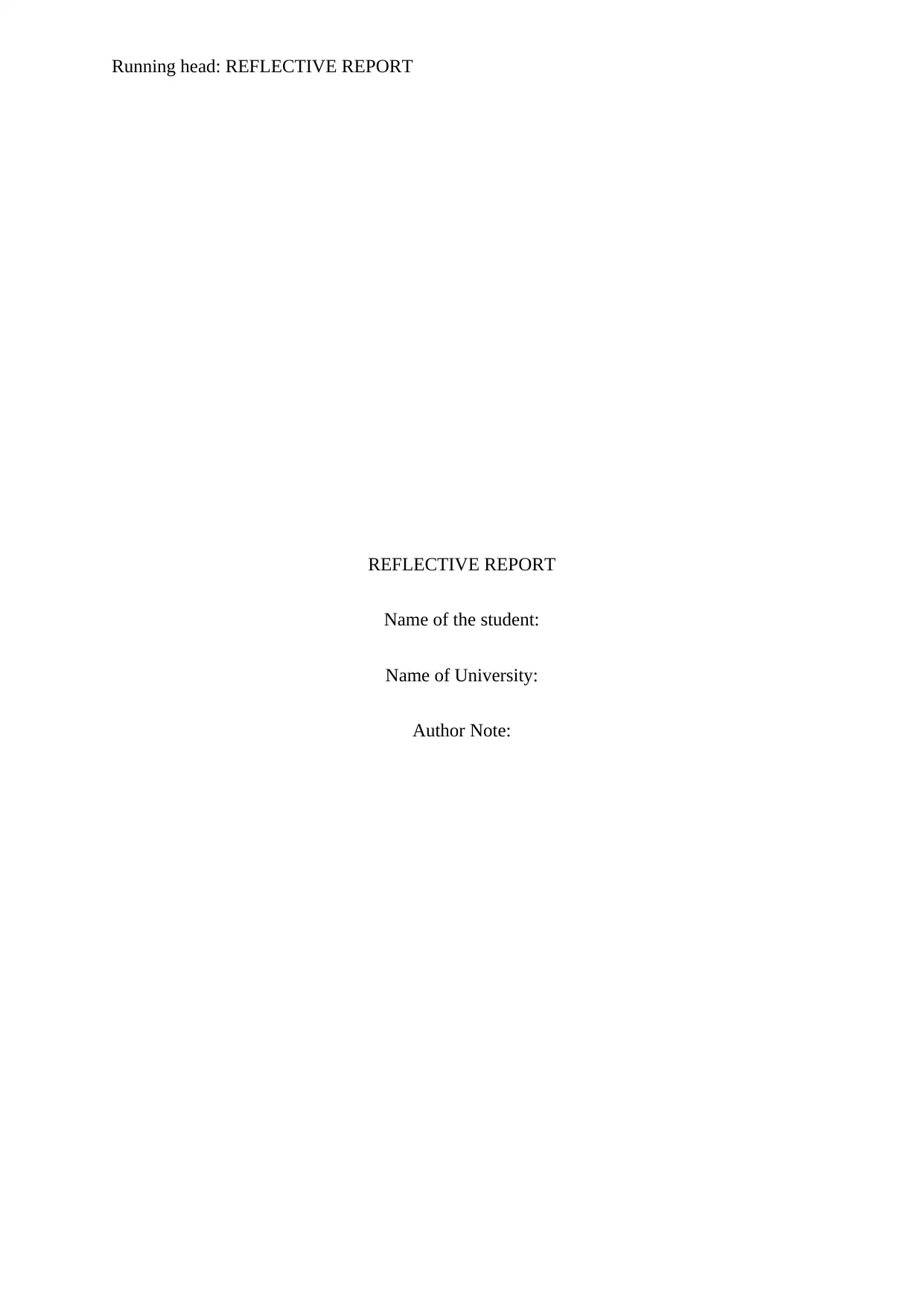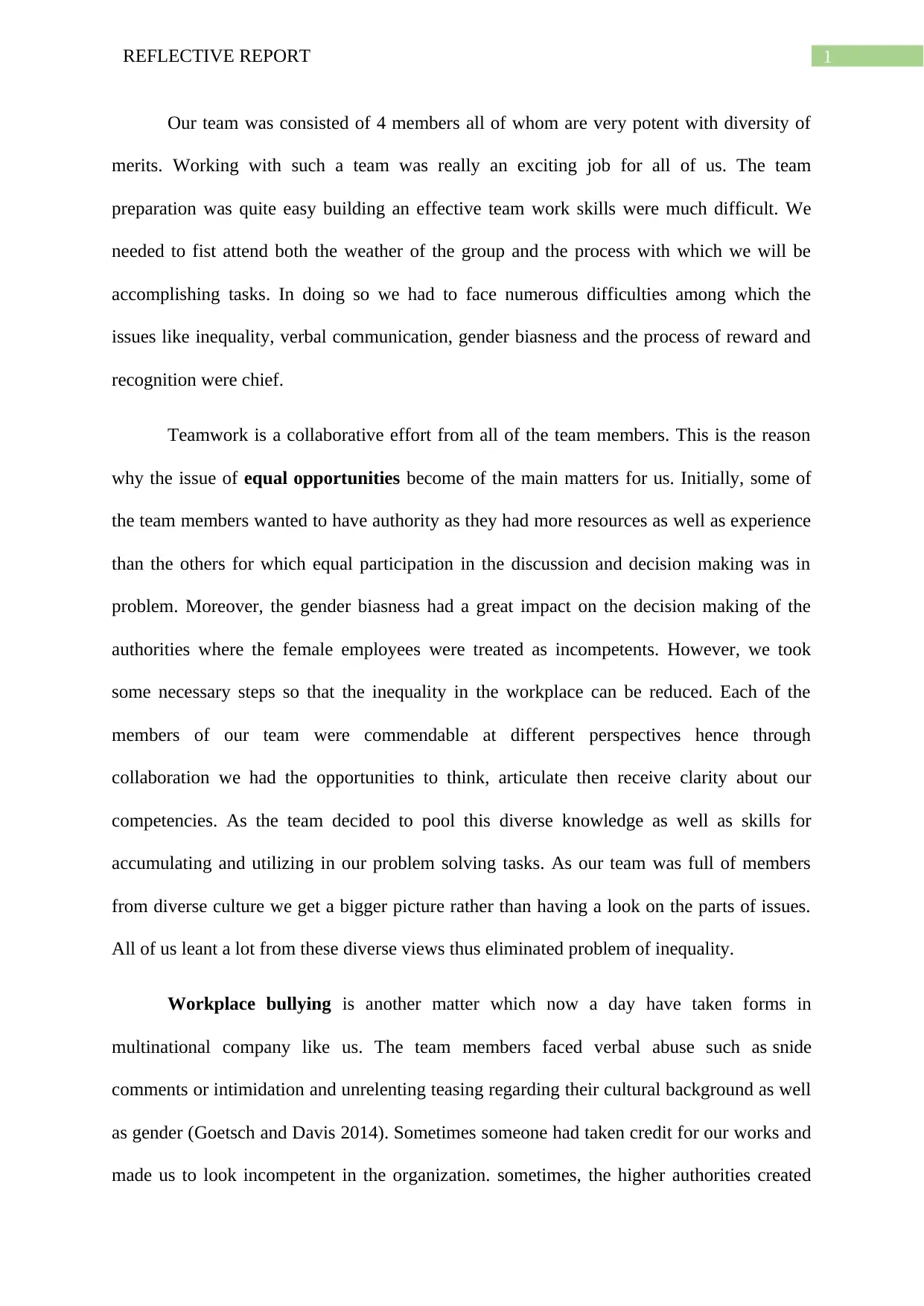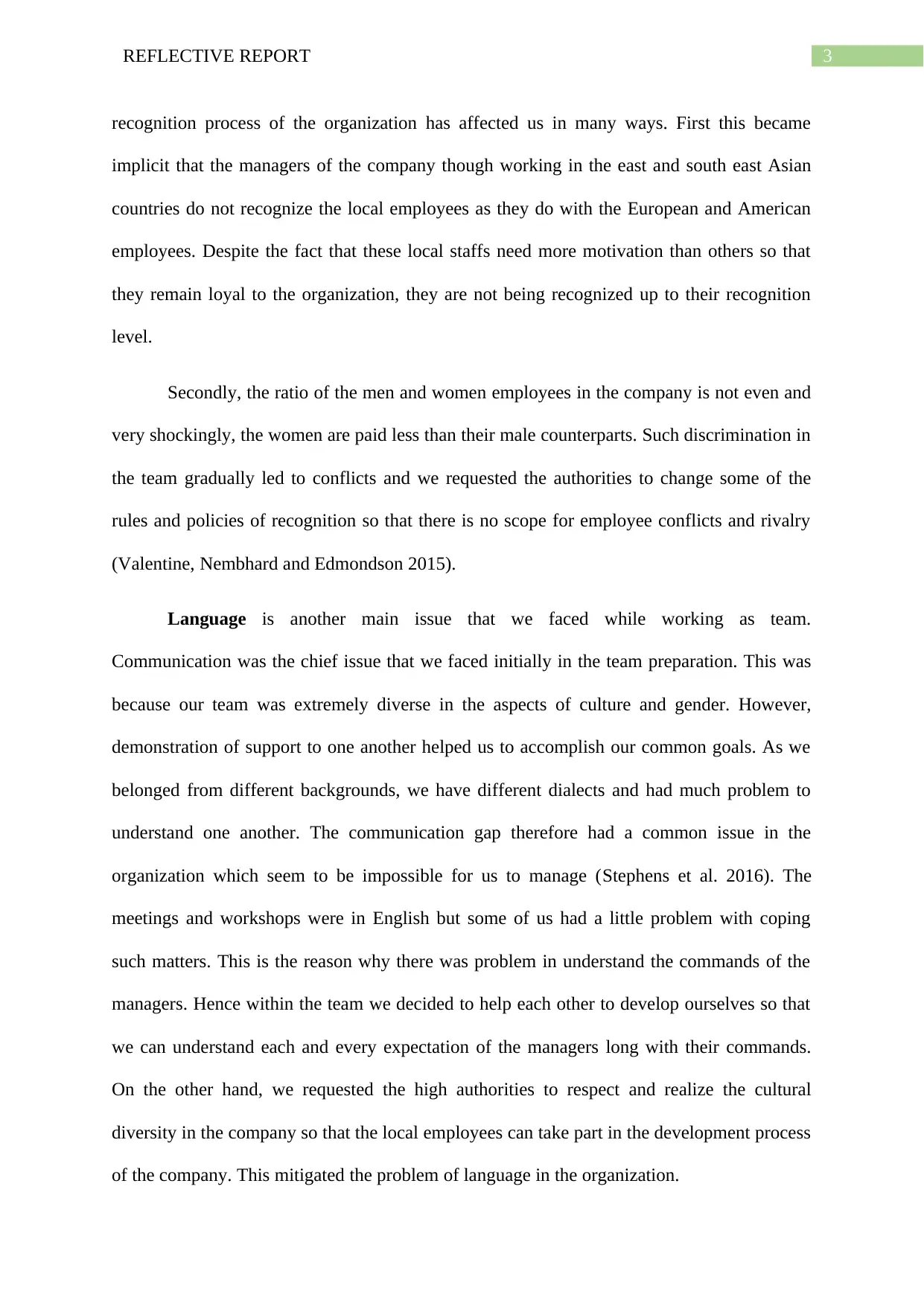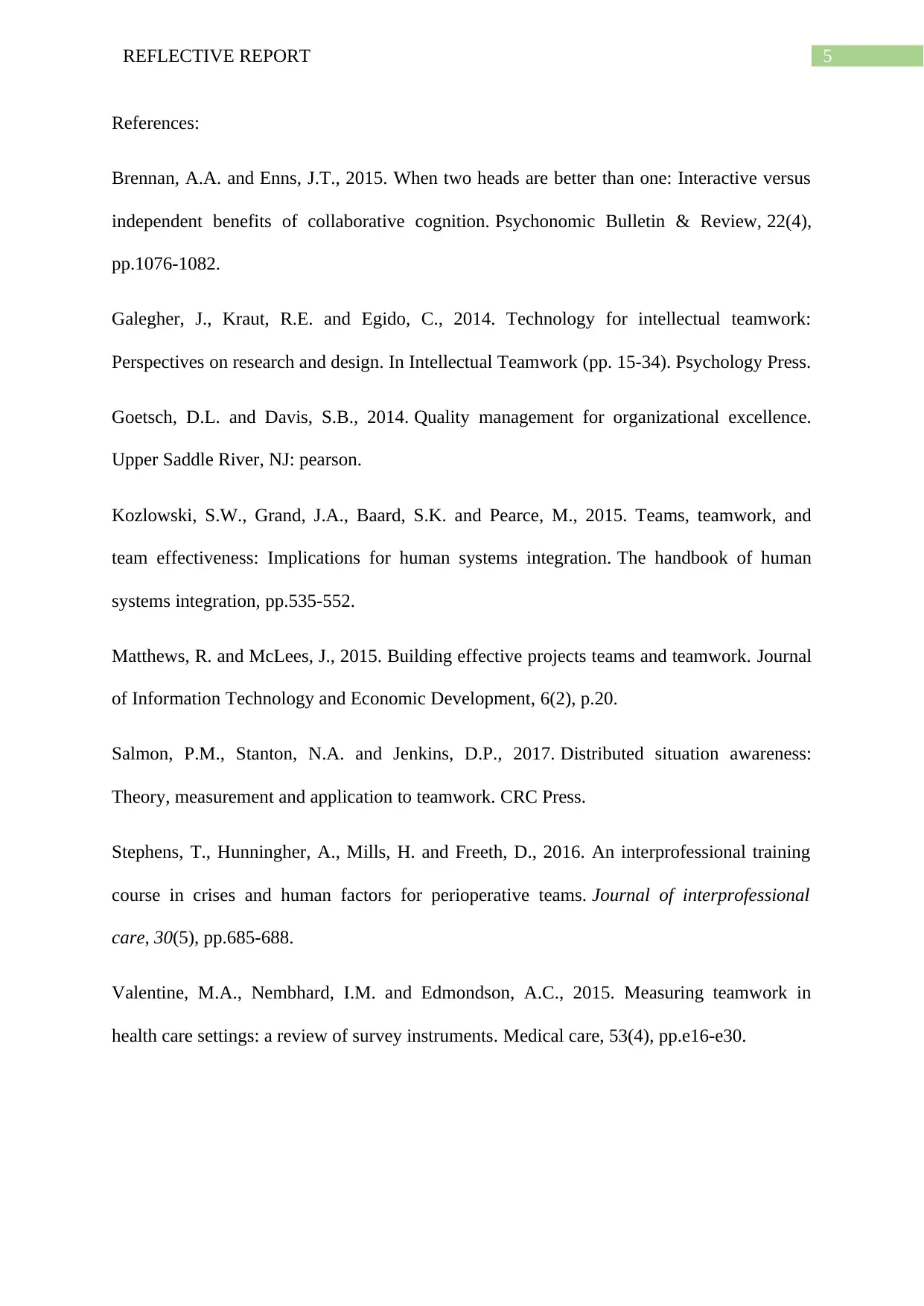University Leadership and Teamwork Reflective Report
VerifiedAdded on 2021/06/18
|6
|1435
|376
Report
AI Summary
This reflective report analyzes the dynamics of teamwork and leadership within a diverse team. The author discusses various challenges encountered, including issues of inequality, verbal communication problems, gender bias, and the impact of cultural diversity. The report highlights how the team addressed these issues, emphasizing the importance of equal opportunities, effective communication strategies, and the significance of employee recognition within a multicultural environment. It also explores the problems of workplace bullying and its impact on team performance, along with the influence of language barriers. The report concludes by emphasizing the importance of adaptability, understanding, and the implementation of inclusive policies to foster a cohesive and productive team environment.

Running head: REFLECTIVE REPORT
REFLECTIVE REPORT
Name of the student:
Name of University:
Author Note:
REFLECTIVE REPORT
Name of the student:
Name of University:
Author Note:
Paraphrase This Document
Need a fresh take? Get an instant paraphrase of this document with our AI Paraphraser

1REFLECTIVE REPORT
Our team was consisted of 4 members all of whom are very potent with diversity of
merits. Working with such a team was really an exciting job for all of us. The team
preparation was quite easy building an effective team work skills were much difficult. We
needed to fist attend both the weather of the group and the process with which we will be
accomplishing tasks. In doing so we had to face numerous difficulties among which the
issues like inequality, verbal communication, gender biasness and the process of reward and
recognition were chief.
Teamwork is a collaborative effort from all of the team members. This is the reason
why the issue of equal opportunities become of the main matters for us. Initially, some of
the team members wanted to have authority as they had more resources as well as experience
than the others for which equal participation in the discussion and decision making was in
problem. Moreover, the gender biasness had a great impact on the decision making of the
authorities where the female employees were treated as incompetents. However, we took
some necessary steps so that the inequality in the workplace can be reduced. Each of the
members of our team were commendable at different perspectives hence through
collaboration we had the opportunities to think, articulate then receive clarity about our
competencies. As the team decided to pool this diverse knowledge as well as skills for
accumulating and utilizing in our problem solving tasks. As our team was full of members
from diverse culture we get a bigger picture rather than having a look on the parts of issues.
All of us leant a lot from these diverse views thus eliminated problem of inequality.
Workplace bullying is another matter which now a day have taken forms in
multinational company like us. The team members faced verbal abuse such as snide
comments or intimidation and unrelenting teasing regarding their cultural background as well
as gender (Goetsch and Davis 2014). Sometimes someone had taken credit for our works and
made us to look incompetent in the organization. sometimes, the higher authorities created
Our team was consisted of 4 members all of whom are very potent with diversity of
merits. Working with such a team was really an exciting job for all of us. The team
preparation was quite easy building an effective team work skills were much difficult. We
needed to fist attend both the weather of the group and the process with which we will be
accomplishing tasks. In doing so we had to face numerous difficulties among which the
issues like inequality, verbal communication, gender biasness and the process of reward and
recognition were chief.
Teamwork is a collaborative effort from all of the team members. This is the reason
why the issue of equal opportunities become of the main matters for us. Initially, some of
the team members wanted to have authority as they had more resources as well as experience
than the others for which equal participation in the discussion and decision making was in
problem. Moreover, the gender biasness had a great impact on the decision making of the
authorities where the female employees were treated as incompetents. However, we took
some necessary steps so that the inequality in the workplace can be reduced. Each of the
members of our team were commendable at different perspectives hence through
collaboration we had the opportunities to think, articulate then receive clarity about our
competencies. As the team decided to pool this diverse knowledge as well as skills for
accumulating and utilizing in our problem solving tasks. As our team was full of members
from diverse culture we get a bigger picture rather than having a look on the parts of issues.
All of us leant a lot from these diverse views thus eliminated problem of inequality.
Workplace bullying is another matter which now a day have taken forms in
multinational company like us. The team members faced verbal abuse such as snide
comments or intimidation and unrelenting teasing regarding their cultural background as well
as gender (Goetsch and Davis 2014). Sometimes someone had taken credit for our works and
made us to look incompetent in the organization. sometimes, the higher authorities created

2REFLECTIVE REPORT
problem by constant criticism and fulfilling impossible expectations. In such cases, we first
checked whether there was something wrong from our part, then started to documenting the
incidents with time, date and location. This was because we needed perfect records to
complain about workplace bully to our higher authorities. Sometimes these bullies became
intolerable due to their irrational nature (Matthews and McLees 2015). This is the reason the
victim started to respond these allegations but these increases day by day. Hence we took our
complaint to the higher authorities and made them realize the situation was taking toll on our
abilities to do our tasks. However, the punitive measures were taken against the alleged and
continued to expand our team skills.
Employee recognition is the process of acknowledging the individual and team
function, effort and attitude to achieve the business goals along with values (Brennan and
Enns 2015). This helps us to work more effectively in the development of the business and
get recognized beyond normal expectations. In our company also the process of rewards and
recognition have a great effect on the efficiency on the employees. The managers understand
our psychology and seriousness with our job and praise us for our good work. As
appreciation is a basic human need, therefore, we respond to the appreciation expressed
through recognition by our managers.
However, as the company operates in various countries, we have culturally diverse
team. Therefore, the expectations of the employees are different from their managers
(Salmon, Stanton and Jenkins 2017). According the cultural dimension index by Hofstede,
some cultures have high ambition to achieve and get recognized in the organization and some
cultures do not believe in the organizational competition among the employees. Hence the
structure of rewards and recognitions affect the employees of the organization’s subsidiaries.
In our team, we all have different cultural background therefore, even if we do not want any
competition within the team and try to keep a healthy ambience in the organization, the
problem by constant criticism and fulfilling impossible expectations. In such cases, we first
checked whether there was something wrong from our part, then started to documenting the
incidents with time, date and location. This was because we needed perfect records to
complain about workplace bully to our higher authorities. Sometimes these bullies became
intolerable due to their irrational nature (Matthews and McLees 2015). This is the reason the
victim started to respond these allegations but these increases day by day. Hence we took our
complaint to the higher authorities and made them realize the situation was taking toll on our
abilities to do our tasks. However, the punitive measures were taken against the alleged and
continued to expand our team skills.
Employee recognition is the process of acknowledging the individual and team
function, effort and attitude to achieve the business goals along with values (Brennan and
Enns 2015). This helps us to work more effectively in the development of the business and
get recognized beyond normal expectations. In our company also the process of rewards and
recognition have a great effect on the efficiency on the employees. The managers understand
our psychology and seriousness with our job and praise us for our good work. As
appreciation is a basic human need, therefore, we respond to the appreciation expressed
through recognition by our managers.
However, as the company operates in various countries, we have culturally diverse
team. Therefore, the expectations of the employees are different from their managers
(Salmon, Stanton and Jenkins 2017). According the cultural dimension index by Hofstede,
some cultures have high ambition to achieve and get recognized in the organization and some
cultures do not believe in the organizational competition among the employees. Hence the
structure of rewards and recognitions affect the employees of the organization’s subsidiaries.
In our team, we all have different cultural background therefore, even if we do not want any
competition within the team and try to keep a healthy ambience in the organization, the
⊘ This is a preview!⊘
Do you want full access?
Subscribe today to unlock all pages.

Trusted by 1+ million students worldwide

3REFLECTIVE REPORT
recognition process of the organization has affected us in many ways. First this became
implicit that the managers of the company though working in the east and south east Asian
countries do not recognize the local employees as they do with the European and American
employees. Despite the fact that these local staffs need more motivation than others so that
they remain loyal to the organization, they are not being recognized up to their recognition
level.
Secondly, the ratio of the men and women employees in the company is not even and
very shockingly, the women are paid less than their male counterparts. Such discrimination in
the team gradually led to conflicts and we requested the authorities to change some of the
rules and policies of recognition so that there is no scope for employee conflicts and rivalry
(Valentine, Nembhard and Edmondson 2015).
Language is another main issue that we faced while working as team.
Communication was the chief issue that we faced initially in the team preparation. This was
because our team was extremely diverse in the aspects of culture and gender. However,
demonstration of support to one another helped us to accomplish our common goals. As we
belonged from different backgrounds, we have different dialects and had much problem to
understand one another. The communication gap therefore had a common issue in the
organization which seem to be impossible for us to manage (Stephens et al. 2016). The
meetings and workshops were in English but some of us had a little problem with coping
such matters. This is the reason why there was problem in understand the commands of the
managers. Hence within the team we decided to help each other to develop ourselves so that
we can understand each and every expectation of the managers long with their commands.
On the other hand, we requested the high authorities to respect and realize the cultural
diversity in the company so that the local employees can take part in the development process
of the company. This mitigated the problem of language in the organization.
recognition process of the organization has affected us in many ways. First this became
implicit that the managers of the company though working in the east and south east Asian
countries do not recognize the local employees as they do with the European and American
employees. Despite the fact that these local staffs need more motivation than others so that
they remain loyal to the organization, they are not being recognized up to their recognition
level.
Secondly, the ratio of the men and women employees in the company is not even and
very shockingly, the women are paid less than their male counterparts. Such discrimination in
the team gradually led to conflicts and we requested the authorities to change some of the
rules and policies of recognition so that there is no scope for employee conflicts and rivalry
(Valentine, Nembhard and Edmondson 2015).
Language is another main issue that we faced while working as team.
Communication was the chief issue that we faced initially in the team preparation. This was
because our team was extremely diverse in the aspects of culture and gender. However,
demonstration of support to one another helped us to accomplish our common goals. As we
belonged from different backgrounds, we have different dialects and had much problem to
understand one another. The communication gap therefore had a common issue in the
organization which seem to be impossible for us to manage (Stephens et al. 2016). The
meetings and workshops were in English but some of us had a little problem with coping
such matters. This is the reason why there was problem in understand the commands of the
managers. Hence within the team we decided to help each other to develop ourselves so that
we can understand each and every expectation of the managers long with their commands.
On the other hand, we requested the high authorities to respect and realize the cultural
diversity in the company so that the local employees can take part in the development process
of the company. This mitigated the problem of language in the organization.
Paraphrase This Document
Need a fresh take? Get an instant paraphrase of this document with our AI Paraphraser

4REFLECTIVE REPORT

5REFLECTIVE REPORT
References:
Brennan, A.A. and Enns, J.T., 2015. When two heads are better than one: Interactive versus
independent benefits of collaborative cognition. Psychonomic Bulletin & Review, 22(4),
pp.1076-1082.
Galegher, J., Kraut, R.E. and Egido, C., 2014. Technology for intellectual teamwork:
Perspectives on research and design. In Intellectual Teamwork (pp. 15-34). Psychology Press.
Goetsch, D.L. and Davis, S.B., 2014. Quality management for organizational excellence.
Upper Saddle River, NJ: pearson.
Kozlowski, S.W., Grand, J.A., Baard, S.K. and Pearce, M., 2015. Teams, teamwork, and
team effectiveness: Implications for human systems integration. The handbook of human
systems integration, pp.535-552.
Matthews, R. and McLees, J., 2015. Building effective projects teams and teamwork. Journal
of Information Technology and Economic Development, 6(2), p.20.
Salmon, P.M., Stanton, N.A. and Jenkins, D.P., 2017. Distributed situation awareness:
Theory, measurement and application to teamwork. CRC Press.
Stephens, T., Hunningher, A., Mills, H. and Freeth, D., 2016. An interprofessional training
course in crises and human factors for perioperative teams. Journal of interprofessional
care, 30(5), pp.685-688.
Valentine, M.A., Nembhard, I.M. and Edmondson, A.C., 2015. Measuring teamwork in
health care settings: a review of survey instruments. Medical care, 53(4), pp.e16-e30.
References:
Brennan, A.A. and Enns, J.T., 2015. When two heads are better than one: Interactive versus
independent benefits of collaborative cognition. Psychonomic Bulletin & Review, 22(4),
pp.1076-1082.
Galegher, J., Kraut, R.E. and Egido, C., 2014. Technology for intellectual teamwork:
Perspectives on research and design. In Intellectual Teamwork (pp. 15-34). Psychology Press.
Goetsch, D.L. and Davis, S.B., 2014. Quality management for organizational excellence.
Upper Saddle River, NJ: pearson.
Kozlowski, S.W., Grand, J.A., Baard, S.K. and Pearce, M., 2015. Teams, teamwork, and
team effectiveness: Implications for human systems integration. The handbook of human
systems integration, pp.535-552.
Matthews, R. and McLees, J., 2015. Building effective projects teams and teamwork. Journal
of Information Technology and Economic Development, 6(2), p.20.
Salmon, P.M., Stanton, N.A. and Jenkins, D.P., 2017. Distributed situation awareness:
Theory, measurement and application to teamwork. CRC Press.
Stephens, T., Hunningher, A., Mills, H. and Freeth, D., 2016. An interprofessional training
course in crises and human factors for perioperative teams. Journal of interprofessional
care, 30(5), pp.685-688.
Valentine, M.A., Nembhard, I.M. and Edmondson, A.C., 2015. Measuring teamwork in
health care settings: a review of survey instruments. Medical care, 53(4), pp.e16-e30.
⊘ This is a preview!⊘
Do you want full access?
Subscribe today to unlock all pages.

Trusted by 1+ million students worldwide
1 out of 6
Related Documents
Your All-in-One AI-Powered Toolkit for Academic Success.
+13062052269
info@desklib.com
Available 24*7 on WhatsApp / Email
![[object Object]](/_next/static/media/star-bottom.7253800d.svg)
Unlock your academic potential
Copyright © 2020–2025 A2Z Services. All Rights Reserved. Developed and managed by ZUCOL.




